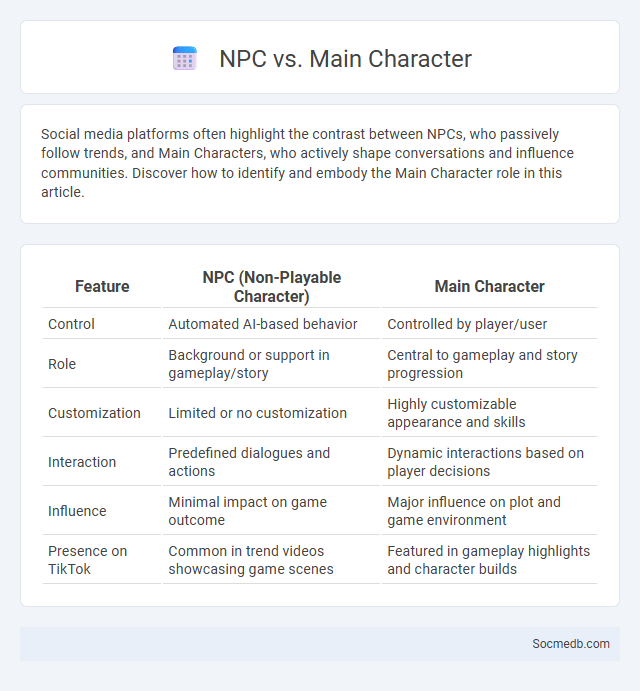
Photo illustration: NPC vs Main Character
Social media platforms often highlight the contrast between NPCs, who passively follow trends, and Main Characters, who actively shape conversations and influence communities. Discover how to identify and embody the Main Character role in this article.
Table of Comparison
| Feature | NPC (Non-Playable Character) | Main Character |
|---|---|---|
| Control | Automated AI-based behavior | Controlled by player/user |
| Role | Background or support in gameplay/story | Central to gameplay and story progression |
| Customization | Limited or no customization | Highly customizable appearance and skills |
| Interaction | Predefined dialogues and actions | Dynamic interactions based on player decisions |
| Influence | Minimal impact on game outcome | Major influence on plot and game environment |
| Presence on TikTok | Common in trend videos showcasing game scenes | Featured in gameplay highlights and character builds |
NPC vs Main Character vs Meme: Key Differences
NPCs on social media represent user behavior driven by repetitive, scripted interactions lacking unique personality, while Main Characters actively create original content and engage meaningfully, shaping platforms with authentic influence. Memes function as viral digital artifacts, distilling cultural trends into shareable humor or commentary that transcends individual identity. Understanding these dynamics reveals how social media ecosystems balance passive consumption, influential presence, and collective creativity.
Origins and Evolution of NPCs, Main Characters, and Memes
Social media platforms played a pivotal role in the emergence and evolution of NPCs (Non-Player Characters), main characters, and memes by providing a dynamic space for cultural exchange and viral content creation. NPCs originated from video game terminology, describing programmed characters with limited interaction, and have since evolved into internet slang used to describe predictable or unoriginal online personas. Memes involving NPCs and main characters rapidly spread across platforms like Twitter, Reddit, and TikTok, morphing into influential digital symbols that reflect social commentary, identity, and humor in contemporary online culture.
Defining the NPC: Characteristics and Usage
The NPC (Non-Playable Character) concept in social media describes users who exhibit predictable, scripted interactions lacking original thought or critical engagement. These profiles often share repetitive content, follow trending opinions without question, and function as echo chambers within online communities. Understanding your exposure to NPC behavior can enhance digital literacy and improve the quality of your social interactions.
Main Character Energy: Traits and Trends
Main Character Energy on social media emphasizes confidence, authenticity, and individuality, appealing to users seeking self-expression and empowerment. Trending content often includes bold visuals, personal storytelling, and motivational themes that resonate with Gen Z and Millennials. Platforms like TikTok and Instagram amplify these traits through viral challenges, influencer personas, and relatable aesthetics that drive engagement and cultural relevance.
Memes: Cultural Impact and Viral Spread
Memes serve as powerful social media tools that shape cultural narratives and reflect societal trends, fostering shared identities across diverse online communities. Their rapid viral spread is driven by relatable humor, visual appeal, and concise messaging, enabling users to engage, comment, and remix content effortlessly. Understanding how memes influence digital communication helps enhance your social media strategy by leveraging viral potential and cultural relevance.
Social Media Dynamics: NPCs, Main Characters, and Meme Archetypes
Social media dynamics are shaped by distinct user roles such as NPCs (Non-Player Characters), main characters, and meme archetypes, each contributing uniquely to online interactions and content creation. NPCs often represent passive consumers or followers, main characters drive narratives and influence trends, while meme archetypes serve as cultural symbols facilitating viral communication. Understanding these roles enhances engagement strategies and community building across platforms like Twitter, Instagram, and TikTok.
Psychological Perspectives: Identity and Group Behavior
Social media profoundly influences identity formation by allowing individuals to curate and express their self-concept through profiles, posts, and interactions. The platforms facilitate in-group and out-group dynamics, reinforcing social identity and group conformity via likes, shares, and community engagement. Psychological theories such as Social Identity Theory and Self-Determination Theory explain how online group behavior impacts self-esteem, social comparison, and collective norms.
Internet Debates: Polarization and Stereotypes
Social media platforms amplify Internet debates by reinforcing polarization and perpetuating stereotypes through echo chambers and algorithm-driven content. Your engagement often exposes you to biased narratives that deepen divisions and hinder constructive dialogue. Understanding these dynamics is crucial to navigating online discussions critically and promoting more balanced perspectives.
NPC, Main Character, and Meme in Pop Culture
NPC (Non-Playable Character) memes have surged on social media, symbolizing individuals perceived as lacking independent thought in pop culture narratives. Main Character memes highlight individuals embracing uniqueness and control over their storylines, reflecting a growing cultural emphasis on self-empowerment. These meme formats dominate platforms like TikTok and Twitter, shaping discussions around identity and societal roles.
Future Trends: The Continued Evolution of NPC and Main Character Memes
NPC and main character memes will dominate social media, reflecting growing user engagement with identity and personalization in digital culture. Advances in AI and augmented reality will enable more interactive and dynamic meme formats, enhancing user creativity and expression. These trends indicate a shift toward immersive storytelling where memes serve as both social commentary and personal branding tools.
 socmedb.com
socmedb.com